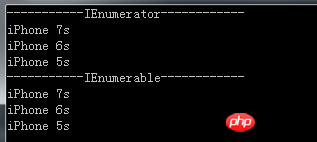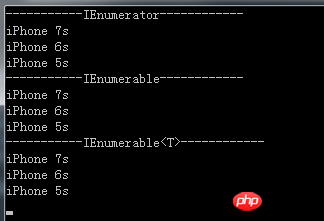C# IEnumerable 및 IEnumerator 인터페이스에 대한 간략한 소개
이 글에서는 C#의 IEnumerable 및 IEnumerator 인터페이스에 대한 관련 지식을 주로 소개하는데, 참고할만한 가치가 매우 높습니다.
리뷰를 통해 살펴보겠습니다. 과거를 배우고 새로운 것을 배울 수 있습니다. 시간이 있을 때 기본 지식을 자주 복습하는 것이 필요하며 이를 통해 이해와 기억이 깊어질 수 있습니다.
Foreach는 컬렉션을 반복하고 IEnumerable 인터페이스를 구현하는 컨테이너를 탐색하는 데 종종 사용됩니다. 공식 설명에 따르면 IEnumerable은 열거자 인터페이스이고 IEnumerator는 약간 혼란스럽습니다. 인터페이스는 문자 그대로의 의미와 크게 다르지 않습니다. 하나씩 분석해 보겠습니다.
IEnumerable 인터페이스
public interface IEnumerable
{
IEnumerator GetEnumerator();
}IEnumerable 인터페이스를 상속하는 클래스는 노출된 GetEnumerator() 메서드를 구현하고 IEnumerator 인터페이스 개체를 반환해야 합니다. 실제로 작업을 수행하는 것은 IEnumerator에 있는 내용을 확인하기 위한 F12입니다.
IEnumerator 인터페이스
public interface IEnumerator
{
object Current { get; }
bool MoveNext();
void Reset();
}IEnumerator 인터페이스에는 세 가지가 있습니다. 하나는 속성Current이고 현재 컬렉션의 요소를 반환하는 MoveNext( ) 이동 다음으로 이동하면 순회가 모두 역순회가 아닌가요? Reset()은 말 그대로 재설정을 의미합니다. 가설을 세웁니다. IEnumerable 인터페이스가 IEnumerator 인터페이스 반복자를 반환하므로 IEnumerator 반복자 인터페이스만 상속하여 사용자 지정 컨테이너를 구현할 수 있습니까?
Phone 클래스
public class Phone
{
public string Name;
public Phone(string name)
{
this.Name = name;
}
}MyEnumerator라는 이름의 반복자를 정의하고 IEnumerator
public class MyEnumerator : IEnumerator
{
Phone[] p;
int idx = -1;
public MyEnumerator(Phone[] t)
{
p = t;
}
public object Current
{
get
{
if (idx == -1)
return new IndexOutOfRangeException();
return p[idx];
}
}
public bool MoveNext()
{
idx++;
return p.Length > idx;
}
public void Reset()
{
idx = -1;
}
}class Program
{
static void Main(string[] args)
{
show("-----------IEnumerator------------");
Phone[] phones = new Phone[] { new Phone("iPhone 7s"), new Phone("iPhone 6s"), new Phone("iPhone 5s") };
MyEnumerator enumerator = new MyEnumerator(phones);
while (enumerator.MoveNext())
{
Phone p = enumerator.Current as Phone;
show(p.Name);
}
Console.ReadKey();
}
static void show(string i)
{
Console.WriteLine(i);
}
}
public class Phone : IEnumerable
{
public string Name ;
public Phone(string name)
{
this.Name = name;
}
Phone[] p;
public Phone(Phone[] t)
{
p = t;
}
public IEnumerator GetEnumerator()
{
return new MyEnumerator(p);
}
}static void Main(string[] args)
{
show("-----------IEnumerator------------");
Phone[] phones = new Phone[] { new Phone("iPhone 7s"), new Phone("iPhone 6s"), new Phone("iPhone 5s") };
MyEnumerator enumerator = new MyEnumerator(phones);
while (enumerator.MoveNext())
{
Phone p = enumerator.Current as Phone;
show(p.Name);
}
show("-----------IEnumerable------------");
Phone phoneList = new Phone(phones);
foreach (Phone p in phoneList)
{
show(p.Name);
}
Console.ReadKey();
}
PhonePackage로 확장합니다. , 일반 IEnumerable
public class PhonePackage<T> : IEnumerable<T>
{
private List<T> dataList = null;
public void Add(T t)
{
if (dataList == null)
dataList = new List<T>();
dataList.Add(t);
}
public IEnumerator<T> GetEnumerator()
{
foreach (T t in dataList)
{
yield return t;
}
}
IEnumerator IEnumerable.GetEnumerator()
{
foreach (T t in dataList)
{
yield return t;
}
}
}
위 내용은 C# IEnumerable 및 IEnumerator 인터페이스에 대한 간략한 소개의 상세 내용입니다. 자세한 내용은 PHP 중국어 웹사이트의 기타 관련 기사를 참조하세요!

핫 AI 도구

Undresser.AI Undress
사실적인 누드 사진을 만들기 위한 AI 기반 앱

AI Clothes Remover
사진에서 옷을 제거하는 온라인 AI 도구입니다.

Undress AI Tool
무료로 이미지를 벗다

Clothoff.io
AI 옷 제거제

AI Hentai Generator
AI Hentai를 무료로 생성하십시오.

인기 기사

뜨거운 도구

메모장++7.3.1
사용하기 쉬운 무료 코드 편집기

SublimeText3 중국어 버전
중국어 버전, 사용하기 매우 쉽습니다.

스튜디오 13.0.1 보내기
강력한 PHP 통합 개발 환경

드림위버 CS6
시각적 웹 개발 도구

SublimeText3 Mac 버전
신 수준의 코드 편집 소프트웨어(SublimeText3)

뜨거운 주제
 7510
7510
 15
15
 1378
1378
 52
52
 78
78
 11
11
 53
53
 19
19
 19
19
 64
64
 C#을 사용한 Active Directory
Sep 03, 2024 pm 03:33 PM
C#을 사용한 Active Directory
Sep 03, 2024 pm 03:33 PM
C#을 사용한 Active Directory 가이드. 여기에서는 소개와 구문 및 예제와 함께 C#에서 Active Directory가 작동하는 방식에 대해 설명합니다.
 C#의 난수 생성기
Sep 03, 2024 pm 03:34 PM
C#의 난수 생성기
Sep 03, 2024 pm 03:34 PM
C#의 난수 생성기 가이드입니다. 여기서는 난수 생성기의 작동 방식, 의사 난수 및 보안 숫자의 개념에 대해 설명합니다.
 C# 데이터 그리드 보기
Sep 03, 2024 pm 03:32 PM
C# 데이터 그리드 보기
Sep 03, 2024 pm 03:32 PM
C# 데이터 그리드 뷰 가이드. 여기서는 SQL 데이터베이스 또는 Excel 파일에서 데이터 그리드 보기를 로드하고 내보내는 방법에 대한 예를 설명합니다.
 멀티 스레딩과 비동기 C#의 차이
Apr 03, 2025 pm 02:57 PM
멀티 스레딩과 비동기 C#의 차이
Apr 03, 2025 pm 02:57 PM
멀티 스레딩과 비동기식의 차이점은 멀티 스레딩이 동시에 여러 스레드를 실행하는 반면, 현재 스레드를 차단하지 않고 비동기식으로 작업을 수행한다는 것입니다. 멀티 스레딩은 컴퓨팅 집약적 인 작업에 사용되며 비동기식은 사용자 상호 작용에 사용됩니다. 멀티 스레딩의 장점은 컴퓨팅 성능을 향상시키는 것이지만 비동기의 장점은 UI 스레드를 차단하지 않는 것입니다. 멀티 스레딩 또는 비동기식을 선택하는 것은 작업의 특성에 따라 다릅니다. 계산 집약적 작업은 멀티 스레딩을 사용하고 외부 리소스와 상호 작용하고 UI 응답 성을 비동기식으로 유지 해야하는 작업을 사용합니다.








